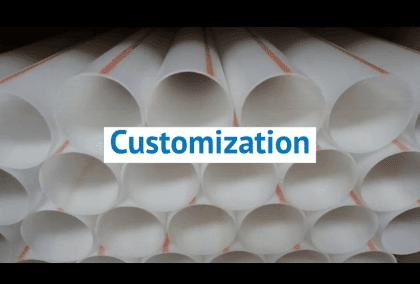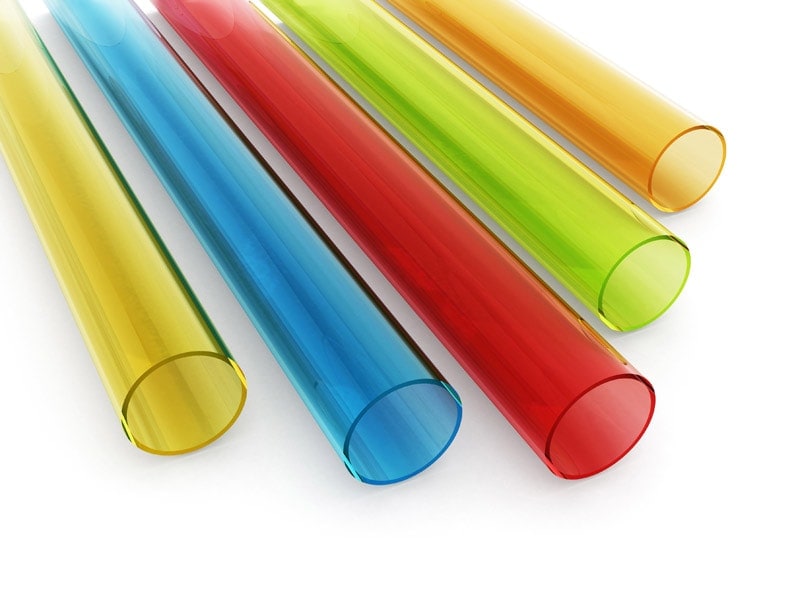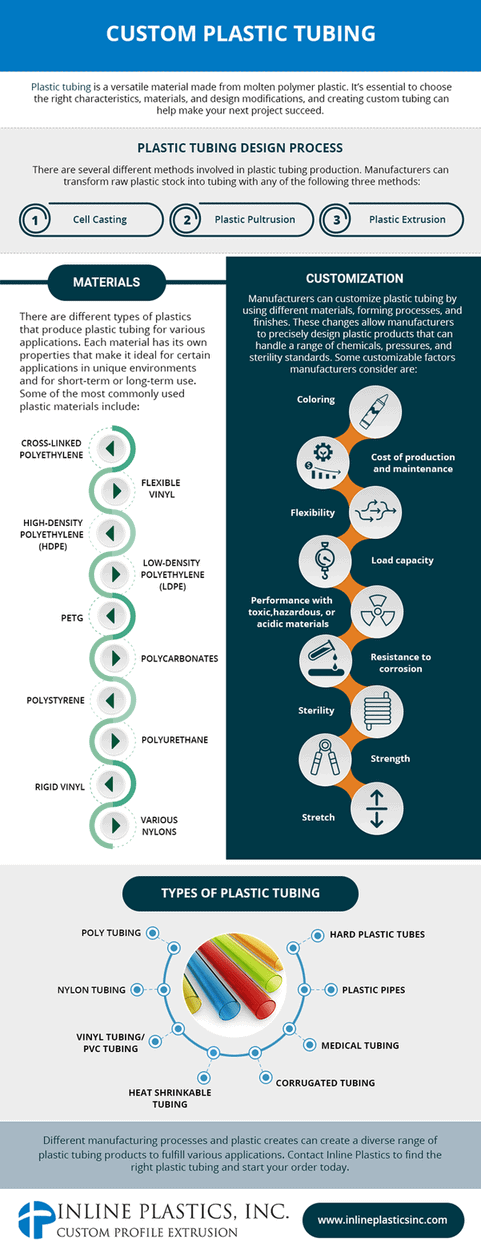Plastic tubing is a versatile material made from molten polymer plastic. Multiple industries, including medical, food and beverage, and construction sectors, use different types of plastic tubing to create safe and long-lasting tools or systems. It’s essential to choose the right characteristics, materials, and design modifications, and creating custom tubing can help make your next project succeed.
History Of Plastic Tubing
Tubing and piping have existed long before plastics. Ancient civilizations around the world used earthen and, later, lead pipes for plumbing. Years later, people in the American West used wooden pipes in the 18th and 19th centuries because the wood was easier to maintain than metal. Iron pipes would quickly degrade due to corrosion and limescale, but redwood would resist damage from weather, insects, acids, and fungus.
The transition to plastic piping and tubing began in 1856 when Alexander Parkes created the first synthetic plastic. This first plastic was cellulose treated with nitric acid and a solvent. Chemists quickly replaced that first plastic—called Parkesine—with countless varieties of plastic. The momentum increased during World War I and World War II. After the wars, the demand for plastics continued to increase. One of the most momentous uses of plastic tubing was using plastic catheters for IVs in 1945.
Plastic Tubing Design Process
There are several different methods involved in plastic tubing production. Manufacturers can transform raw plastic stock into tubing with any of the following three methods:
1. Cell Casting
Cell casting is the traditional method of creating tubing. Manufacturers would pour molten plastic into pre-made tube shapes, where it would cool and harden. While this method can still be used today, it has several flaws. The process is labor and time-intensive and, because it’s so manual, the products are inconsistent. Cell casting is also very expensive.
2. Plastic Pultrusion
In the plastic pultrusion process, manufacturers combine plastic resins and fibers to create a new, extremely durable material. From there, pultrusion materials can fulfill many applications such as tubing, moving items, and equipment.
3. Plastic Extrusion
This method is the most efficient and commonly used. Almost every industry uses extruded plastic products and plastic tubes. This process allows manufacturers to create plastic tubing with almost any thickness or width for different applications.
To start, manufacturers load raw plastic stock onto a hopper, which is suspended above a conveyance channel. The conveyance channel holds a long screw. The extrusion equipment pushes the raw stock from the hopper into the long, turning screw. The friction from the turning screw, as well as additional heat, melts the plastic into a malleable liquid state before it reaches the end of the conveyance channel.
After that, the melted material is shaped by a metal die. The die forces the molten plastic into a specifically shaped hole, and the plastic cools into lengths of plastic tubing. From there, manufacturers can cut the tubing to length, package it, and ship it. The plastic tubing can also be processed and finished into more refined products.
Materials
There are different types of plastics that produce plastic tubing for various applications. Each material has its own properties that make it ideal for certain applications in unique environments and for short-term or long-term use. Some of the most commonly used plastic materials include:
- Cross-linked polyethylene
- Flexible vinyl
- High-density polyethylene (HDPE)
- Low-density polyethylene (LDPE)
- PETG
- Polycarbonates
- Polystyrene
- Polyurethane
- Rigid vinyl
- Various nylons
Customization
Manufacturers can customize plastic tubing by using different materials, forming processes, and finishes. These changes allow manufacturers to precisely design plastic products that can handle a range of chemicals, pressures, and sterility standards. Some customizable factors manufacturers consider are:
- Coloring
- Flexibility
- Load capacity
- Performance with toxic, hazardous, or acidic materials
- Resistance to corrosion
- Sterility
- Strength
- Stretch
Manufacturers also analyze the physical structure of the tubing to create the best final design. For example, the wall thickness, total diameter, and coating length can limit or enhance the tubing’s performance. Coatings and fittings can also make tubing perform better or for longer. Another consideration is the cross-sectional shape of the tubing. Instead of round tubing, some fabricators create square tubes or more complex tubes for different applications.
Types Of Plastic Tubing
Acrylic Tubing
This tubing is also called clear plastic tubing because the colors can be anything from opaque to nearly transparent. These tubes are ideal for applications that require close observation of the tubing contents. Their clarity allows users to monitor fluid conditions, especially for medical purposes. Acrylic tubes can also hold coloring, which makes it easier for users to organize and sort tubing intended for different purposes.
Poly Tubing
Polyethylene tubing comes in two main categories:
- High-density polyethylene (HDPE) tubing, which is sturdy, durable, and ideal for high-impact applications.
- Low-density polyethylene (LDPE) tubing, which is more flexible and ideal for pneumatic systems.
Both materials are sturdier than acrylic tubing.
Nylon Tubing
Just like LDPE tubing, nylon tubing can handle pneumatic applications. This material is resistant to heat and cracking. Typical applications include automotive fuel lines, refrigerator water lines, and irrigation tubing. The following industries commonly use nylon tubing as their default choice:
- Aerospace
- Agriculture
- Filtration
- Laboratories
- Medical Technology
While most nylons are synthetic, raw nylon can produce tubing without having a petroleum base.
Vinyl Tubing/PVC Tubing
Vinyl tubing also encompasses polyvinyl chloride, or PVC, tubing. PVC is extremely versatile and can be used for consumer, commercial, and industrial applications. This material doesn’t corrode or conduct electricity, making it ideal for construction purposes. It’s also non-toxic and won’t degrade in the presence of temperature extremes or varying pressures, making it extremely tough.
Common applications of vinyl and PVC tubing include:
- Brewing facilities
- Construction materials
- Consumer goods
- Food processing plants
- Heating and cooling systems
- Industrial wastewater management facilities
- Plumbing
- Pool operations
Heat Shrinkable Tubing
This specialty tubing product shrinks once it’s heated. It can create a right, form-fitting insulation cover.
Corrugated Tubing
The circumference of corrugated tubing has ridges and perpendicular valleys to give it an extremely sturdy structure. Corrugated tubing has a low flow rate and is commonly used in medical applications, including anesthesia administration and respiratory ventilators. Most corrugated tubing is made from nylon, polyethylene, polyurethane, PVC, or other low-density linear plastics. It can also be produced in a variety of diameters, though the standard size is 10 mm for most applications.
Medical Tubing
This is a broad category of tubing that can be used in medical applications and commonly includes IV drips, catheters, and surgical tools.
Plastic Pipes
Plastic piping is also an informal category. Generally, “plastic piping” refers to rigid plastic tubes. Suppliers measure plastic piping by its inner diameter (ID).
Hard Plastic Tubes
Hard plastic tubes are less rigid than plastic pipes. This material is strong and resists damage from abrasion or kinks in the length of the tube. Acrylics and polycarbonates are popular choices for hard plastic tubes, and the final products can be clear or opaque.
Applications For Plastic Tubing
Every type of plastic tubing has its own uses and applications. Some of the most common include:
- Agriculture
- Automobile manufacturing
- Building and construction
- Chemical processing and transfer
- Electrical installations
- Fluid management
- Food and beverage processing
- Hydraulic and pneumatic systems
- Industrial and commercial cleaning equipment
- Laboratory and medical equipment
Contact Inline Plastics Today To Start Your Custom Plastic Tubing Order
Our variety of manufacturing processes can create a diverse range of plastic tubing products to fulfill various applications. Depending on the material, plastic tubing can be flexible, rigid, transparent, opaque, and more! For more information about our plastic tubing customization capabilities, feel free to contact Inline Plastics or fill out an RFQ form for more information today!


